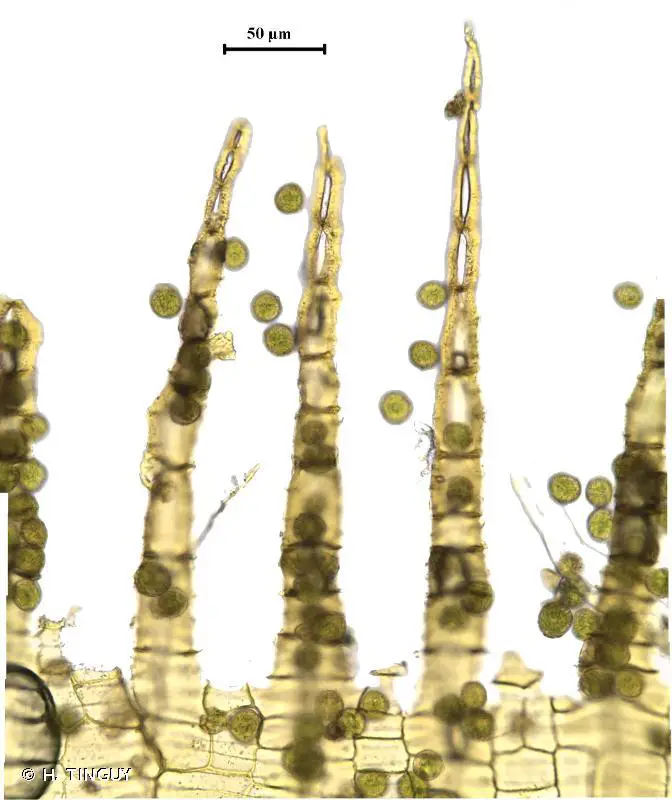
PB_Breutelia_azorica_2.jpg from: https://azoresbioportal.uac.pt/pt/especies-dos-acores/breutelia-azorica-12085/
Pireella trichomanoides: The Fascinating Feather Moss
Introduction
Pireella trichomanoides (Spruce ex Mitt.) Cardot, commonly known as Pireella moss or feather moss, is a captivating species of moss belonging to the Pterobryaceae family. This tiny but mighty plant plays important ecological roles and boasts unique adaptations. Let’s dive in and learn more about this marvelous moss!

blunt-feather-moss-homalia-trichomanoides-uk-BK83EE.jpg from: https://www.alamy.com/stock-photo-blunt-feather-moss-homalia-trichomanoides-uk-29067206.html
Background
Pireella is a genus of mosses in the order Bryopsida, which contains most of the 12,000 moss species. Mosses are non-vascular plants in the division Bryophyta. They lack true roots, stems, and leaves, instead having structures that serve similar functions. Mosses reproduce via spores rather than seeds and are found in diverse habitats worldwide.
Morphology and Identification
P. trichomanoides forms dense mats with a feathery appearance, hence its common name. The stems are creeping and irregularly branched, reaching 1-3 cm long. Leaves are ovate-lanceolate, 1-2 mm long, and have a costa (midrib) that extends 1/2 to 2/3 the leaf length. Leaf margins are entire or minutely toothed near the apex.
Distinguishing features include:
- Complanate (flattened) leaf arrangement
- Leaves curved or undulate when dry
- Leaf cells elongate, smooth
- Autoicous (male and female reproductive structures on same plant)
Global Distribution and Habitat
This species has a pantropical distribution, found in tropical regions of North America, South America, Africa, and Asia. It grows as an

il_fullxfull.2693936910_7ejr.jpg from: https://www.thebryophytanursery.com/listing/912935195/homalia-trichomanoides-moss-and
epiphyte on tree trunks and branches in moist, shady forests from lowlands to 2000 m elevation. P. trichomanoides prefers humid habitats with high rainfall.

38883896761_d504f341a9_b.jpg from: https://www.flickr.com/photos/98771984@N05/38883896761/

phyllocladus-trichomanoides.jpg from: https://leafland.co.nz/trees/phyllocladus-trichomanoides/
Ecological Roles and Adaptations
Like other mosses, Pireella plays vital roles in its ecosystem:
- Provides shelter and habitat for micro-organisms and invertebrates
- Helps retain moisture and stabilize soil
- Pioneers on bare substrates, paving the way for other plants
- Indicator of air and water quality
Adaptations of P. trichomanoides include:
- Efficient water and nutrient uptake through leaves

Davallia_trichomanoides3-500×500.jpg from: https://www.glasshouseworks.com/davallia-trichomanoides
- Desiccation tolerance – ability to dry out and rehydrate
- Asexual reproduction via fragmentation
- Spore dispersal by wind

2020-10-28-10-59-21.jpg from: https://www.britishbryologicalsociety.org.uk/learning/species-finder/homalia-trichomanoides/

837152.jpg from: https://www.bio-forum.pl/messages/3280/837146.html

P.-alpinum.jpg from: https://blogs.ubc.ca/biology321/?page_id=1757
| Characteristic | Description |
|---|---|
| Genus | Pireella |
| Species | P. trichomanoides |
| Family | Pterobryaceae |
| Order | Bryopsida |
| Division | Bryophyta |
| Growth Form | Creeping, branched stems |
| Leaf Shape | Ovate-lanceolate |
| Leaf Size | 1-2 mm long |
| Costa | 1/2 to 2/3 leaf length |
| Habitat | Epiphytic in tropical forests |
| Elevation Range | 0-2000 m |
| Distribution | Pantropical |
Conclusion
Pireella trichomanoides is a small but spectacular moss with an important story to tell. From its feathery form to its fascinating ecology, this species reminds us to appreciate the miniature marvels living all around us. Next time you walk in the woods, take a closer look – you may just spot this plucky Pireella! What other mighty mosses have you encountered?

209932.jpg from: https://inpn.mnhn.fr/espece/cd_nom/5118